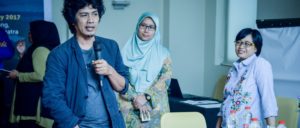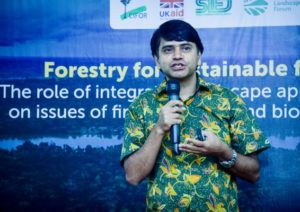For some residents of South Sumatra, Indonesia, peat is a constant preoccupation.
“Life keeps getting harder,” says 53-year-old Maemunah. She lives in Talangnangka village in the center of the province, among peatland that was once covered in forest.
Large swathes have now been drained and set alight in order to clear space for agricultural use, setting off a dangerous ripple effect. The local rubber plantation was recently caught up in one of the fires and was completely destroyed. Water levels in the rivers have also dropped as the peat around them dries.
“Now it’s difficult to find fish,” says Maemunah. “Before, I could sell them and get Rp 100,000 [US$7.50] a day. Now, earning Rp 10,000 [75 cents] is a struggle. Peat should be looked after, but it’s not.”
Read also: Eyes on the livelihoods of peatland communities
In Prigi village, Yandri farms rice and is used to slashing and burning his fields every year to get rid of pests and allow the ash to fertilize the soil. He knows the practice is now illegal, as authorities try to protect peatlands, but he has no idea what alternative to turn to.
“Those of us from the community don’t understand how to manage peatland correctly,” he says.
SOUTH SUMATRA BURNING
The confusion among locals about how to effectively handle the peatlands they depend on significantly contributes to South Sumatra’s problems. The province is home to some of the largest areas of peat in Indonesia.
It has also experienced some of the country’s largest forest fires as these zones are converted into agricultural plantations to make products like palm oil. In the process, huge amounts of carbon have been released from the peat into the atmosphere. Rare plants and animals have been also been destroyed and the toxic air has caused long-term public health concerns.
Researchers are desperate to stem the tide and local people’s uncertainty by reaching them with important messages that can protect peatlands and their livelihoods. They also want to effectively communicate the personal struggles of people living on peatlands to policymakers.

JOINING FORCES WITH JOURNALISTS
Many believe the media could hold the key. Television is the dominant source of news and entertainment in Indonesia. Radio and newspapers are also common, with radio in particular as an important way to reach people in remote rural areas. Online readership is growing, with recent studies suggesting a rapidly growing rate of Internet access and social media use across the country.
“To make scientific language popular, we need the media,” says Budhy Kristanty, Communications Coordinator for Indonesia at the Center for International Forestry Research (CIFOR), which leads the CGIAR Research Program on Forests, Trees and Agroforestry (FTA) with its partners. Kristanty recently organized a media training workshop, The role of integrated landscapes on issues of fires, peatland and bioenergy, for 40 Indonesian journalists in Palembang, South Sumatra.
“The media can become an agent of change that can encourage behavioral changes,” she says.
“We write and it’s understood by the common people, and understood by professors,” says Muhammad Arif Eko Wibowo, a journalist from MNC Media South Sumatra, who attended the workshop.
WHEN SCIENCE MEETS MEDIA
With a team of four CIFOR scientists, Kristanty ran two days of training for 40 journalists – some with extensive knowledge of peatlands, some with little or none. As well as a field visit to an affected community, it included presentations by the scientists on peat and deforestation and introductions to their research projects on bioenergy and conservation in Indonesia.
“It’s really important to have science communicated to wider communities including the media,” says Himlal Baral, a senior scientist at CIFOR, who presented his research on using bioenergy crops to restore degraded lands in Kalimantan, Indonesia, during the training.

“As a scientist, we investigate answers to complex issues and we present them in scientific papers or journals, which are not much of interest to wider communities, especially local communities or policymakers,” he says. “Media can help turn them into a simpler form.”
Research has already shown some positive engagement by Indonesian media on related issues, such as the REDD+ project that aims to reduce emissions from deforestation and foster conservation.
However, overall, the media still has a ways to go.
“It turns out basic knowledge on peatlands, forests and the environment is generally lacking,” says Kristanty. “Some local journalists here don’t even know what peatlands are, or why peatland conservation is important.”
What’s more, getting media interested in covering stories with scientific angles can be difficult.
“In Indonesia, in my opinion, the general media is rarely interested in covering environmental news unless there’s a major event, which makes it important to cover, like forest fires, or floods and landslides,” says Kristanty.
After meeting and interviewing scientists directly during the sessions, journalists revealed their own analysis on the lack of scientific coverage in their media: A shortage of sources.
“We tend to have trouble finding researchers in the region who are concerned about discussing environmental issues,” says Tasma Sindo, a journalist with Koran Sindo newspaper in Palembang. “For instance, it’s hard for us to compare academics or the opinions of NGOs in the region; there tends to be a bias with news only coming from the government or other official stakeholders.”
THE BONN CHALLENGE
The media training was timed to run in conjunction with the Bonn Challenge High-Level Roundtable Meeting in Palembang, South Sumatra a few days later (May 9-10).
Started in 2011, The Bonn Challenge is a global effort to restore 150 million hectares of the world’s deforested and degraded land by 2020 and 350 million hectares by 2030. It’s designed to help countries realize existing international commitments, including REDD+. To date, 44 governments, alliances and private sector organizations have committed to restoring over 150 million hectares of land to help meet the challenge.
Although not yet officially part of the Bonn Challenge, Indonesia has vowed to restore more than 29,000,000 hectares of land. In order to help meet this, the government has already set up the national Peatland Restoration Agency, outlawed slash and burn techniques and banned the conversion of peatlands to agricultural plantations.
Read also: Peatlands: The view from space
Scientists hope that if the media can help publicize their research on mitigating climate change and balancing livelihoods on degraded peatlands by turning to sustainable solutions like bioenergy and landscape restoration, local communities will be able to do more to contribute to these objectives.
“The Bonn Challenge is key for restoration because they have a target,” says Herry Purnomo, a CIFOR scientist who took part in the training. “It’s important for media to support that kind of vision, that kind of action.”
Back on the peatlands, Maemunah and Yandri are anxious for just this kind of practical information that could help them safely continue making their living. Researchers hope that not only will media outlets reach them with relevant news directly, but journalists will also help transmit their experiences to the provincial and national capitals, to help bring about broader change.
By Leona Liu and Rose Foley, originally published at CIFOR’s Forests News.
For more information on this topic, please contact Budhy Kristanty at b.kristanty@cgiar.org.
This research forms part of the CGIAR Research Program on Forests, Trees and Agroforestry. This work is supported by CGIAR Fund Donors.











